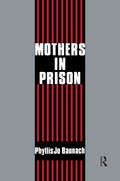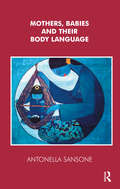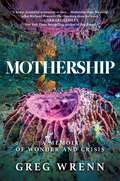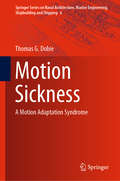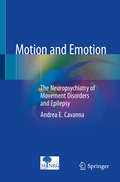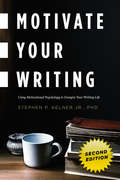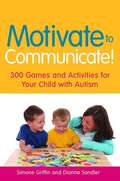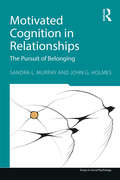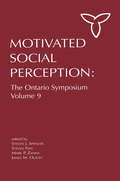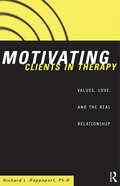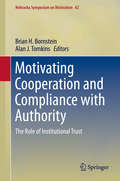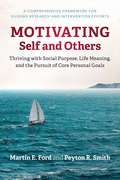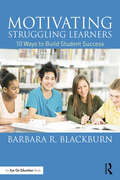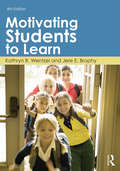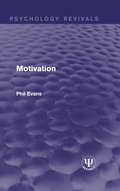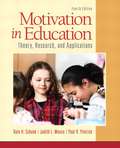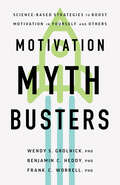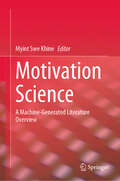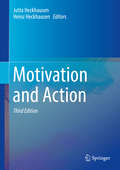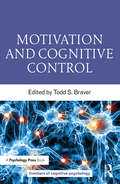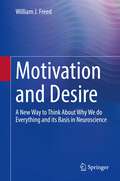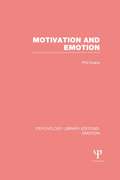- Table View
- List View
Mothers in Prison
by Phyllis Jo BaunachSeveral years ago, Terry Moore, a young first offender at the Florida Correctional Institution for Women, gave birth to a baby whose father was a prison guard. Mrs. Moore won the right to have her baby stay with her in prison until she was released a few months later. Although this incarcerated mother was reunited with her child shortly after giving birth, many inmate mothers are not able to be with or see their children on a regular basis during incarceration. Little is known about this significant and emotionally traumatic problem that confronts nearly two-thirds of incarcerated women.Building upon previous work, this extraordinarily insightful volume offers fresh perspective on issues which surround the separation of inmate mothers and their children, using questionnaire, standardized scales, and individual taped interviews. The author examines issues such as the impact of separation by race; the child's whereabouts at the time of the crime; the child's placement and legal custody during the mother's incarceration; inmate mothers' interest in resuming the parental role after release; child-rearing attitudes of inmate mothers; and the effects of the involvement of drugs on the mothers' relationship with their children.Through interviews with administrators, staff, and inmates, Dr. Baunach provides a detailed, descriptive analysis of the development and operations of programs to retain mother-child bonds in women's prisons in a variety of states. Dr. Baunach discusses day-long/overnight/weekend visitations, foster care placements, and similar problems of the sort that mothers in prison uniquely must face. The work also has a strong policy content, providing unique and practical recommendations for policies and programs benefiting inmate mothers and children that at the same time can be implemented within the framework of current penological practices.
Mothers, Babies and their Body Language
by Antonella SansoneThis book emphasizes the importance of communication and early attachment for babies, acknowledging the value of both mother and father "being there" for their baby during pregnancy and after birth, with "quality time" to acknowledge, respect, and enjoy the presence of their baby.
Mothership: A Memoir of Wonder and Crisis
by Greg WrennA dazzling, evidence-based account of one man&’s quest to heal from complex PTSD by turning to endangered coral reefs and psychedelic plants after traditional therapies failed—and his awakening to the need for us to heal the planet as well.Professor Greg Wrenn likes to tell his nature-writing students, &“The ecological is personal, and the personal is ecological.&” What he&’s never told them is how he&’s lived out those correspondences to heal from childhood abuse at the hands of his mother. Weaving together memoir and cutting-edge science, Mothership is not just a queer coming-of-age story. It&’s a deeply researched account of how coral reefs and a psychedelic tea called ayahuasca helped Greg heal from complex PTSD—a disorder of trust, which makes the very act of bonding with someone else panic-inducing. From the tide pools in Florida where he grew up, to Indonesia&’s Raja Ampat archipelago and the Amazon rainforest, this is his search for wholeness when talk therapy and pharmaceuticals did little to help. Along the way, as his ecological conscience wakes up, he takes readers underwater to the last pristine reefs on earth, and into the psyche.Written with prophetic urgency, Mothership ultimately asks if doses of nature will be enough to save us before it&’s too late.
Motion Sickness: A Motion Adaptation Syndrome (Springer Series on Naval Architecture, Marine Engineering, Shipbuilding and Shipping #6)
by Thomas G. DobieThis book offers a survey of the state of the art in the field of motion sickness. It begins by describing the historical background and the current definition of motion sickness, then discusses the prevalence among individuals, along with the physiological and psychological concomitants of the disorder. It reviews the incidence of motion sickness in numerous provocative motion environments and discusses various personal factors that appear to influence this aspect. Various characteristics of provocative motion stimuli are also described, together with the results of studies conducted in the laboratory, on motion simulators and at sea. Laboratory tests that could potentially be used to assess an individual’s susceptibility to motion sickness and his or her ability to adapt to motion environments are presented in detail, together with the ways in which individuals might be trained to prevent motion sickness or more effectively cope with motion environments. In closing, the book reports on the cognitive-behavioral approach developed by the author (Dobie, 1963) as well as the various desensitization programs employed in military settings, and discusses the relative effectiveness of these methods in comparison to cognitive-behavioral counseling.
Motion and Emotion: The Neuropsychiatry Of Movement Disorders And Epilepsy
by Andrea E. CavannaThis book illustrates the clinical interface between neurology and psychiatry by focusing on neuropsychiatric conditions characterised by alterations at the level of both motor function and behaviour. The neuropsychiatric approach to movement disorders and epilepsy is of key importance in clinically assessing and treating these common and often disabling conditions. While addressing the clinical challenges posed by the behavioural aspects of movement disorders and epilepsy, it invites readers on a journey through the evolving discipline of neuropsychiatry / behavioural neurology – both in the past and today. This discipline has an illustrious history, and continues its ascending trajectory in the new millennium through the activity of long-established national organisations (British Neuropsychiatry Association, BNPA, and American Neuropsychiatric Association, ANPA) as well as newly developed strategic research initiatives (Michael Trimble Neuropsychiatry Research Group, MTNRG).
Motivate Your Writing: Using Motivational Psychology to Energize Your Writing Life
by Stephen P. Kelner Jr.Energize and organize your writing life by tapping into your fundamental motivators.Note: This second edition has been substantially revised and updated, including 10% more content than the first edition.Aspiring and professional writers alike struggle to stay motivated; in the face of distractions, obligations, and procrastination, the desire to write often fails to become the act of writing. Motivated writers, notes the author, are those who have learned to identify their fundamental emotional drives and who have established a writing routine that satisfies those drives. Kelner draws on the research and insights of motivational psychology to show writers how to harness the energy of these fundamental motivators. With a degree in motivational psychology, Kelner applies not only his training in the field but also his own original research into the motivational patterns typical of writers. Depending on their motivational profile, different writers will respond best to different kinds of feedback and rewards and will function best in different kinds of environments. Kelner explains the basic drives of power, affiliation, and achievement; he shows how these drives are manifested in a wide variety of behaviors; and he provides self-assessment tools to construct your own motivational profile. In clear and accessible terms, and with numerous examples and anecdotes, Kelner shows writers how they can identify their own primary motivations and use that knowledge to arrange their work habits and energize their writing lives.
Motivate to Communicate!
by Simone Griffin Dianne SandlerThis practical resource is brimming with exciting ideas and guidance for motivating children with autism and other communication difficulties. The clear, user-friendly format enables quick access to over 300 practical, fun-filled games and activities for developing your child's communication skills. The book suggests creative ways to use everyday toys and objects. For example, if your child likes to pop bubbles, perhaps he would also enjoy counting bubbles, catching bubbles on a wand, stomping them with his feet or even playing bubble volleyball! The innovative ideas in this book have been developed over 40 years of clinical and educational experience, and are designed to be fun for both the adult and the child. All resources mentioned in this book are readily available and can be used to advance communication skills at all levels, from reaching out for an item, to extending verbal communication. Motivate to Communicate! is perfect for supporting parents, care-givers and professionals in motivating and developing the communication skills of children on the autism spectrum.
Motivated Cognition in Relationships: In Pursuit of Safety and Value (Essays in Social Psychology)
by John G. Holmes Sandra L. MurrayHow can newlyweds believe they will be together forever, while knowing that the majority of marriages end in divorce? Why do people who desperately want to be loved end up alienating those who love them? How can partners that seem like complete opposites end up blissfully happy? This volume explores such fascinating questions. Murray and Holmes outline how basic motivations to be safe from being hurt and find value and meaning control how people feel, think, and behave in close relationships. Additionally, the authors highlight how these motivations infuse romantic life through succinct and accessible descriptions of cutting-edge empirical research and vivid evolving stories of four couples confronting different challenges in their relationship. Integrating ideas from the interdependence, goals, and embodiment literatures, this book puts a provocative new spin on seminal findings from two decades of collaborative research. The book: provides a new, interdependence-based, perspective on motivated cognition in close relationships; advances a dyadic perspective that explores how motivation shapes perception and cognition in ways that result in motivation-consistent behavior; examines how "goal-driven" cognition translates a person’s wishes, desires, and preferences into judgement and behavior, and ultimately, his or her romantic partner’s relationship reality; offers a refreshing argument that the ultimate effects of motivated cognition on satisfaction and stability depend on whether the motivations which most frequently guide perception and cognition match the reality constraints imposed by the perceiver, the partner, and the characteristics of the relationship. This book is essential for social and personality psychologists and will also be valuable to clinical psychologists and clinicians who work directly with couples to effect more happy and stable relationships. Advanced undergraduate and graduate students will find it a highly engaging compendium for understanding how motivation shapes affect, cognition, and behavior in close relationships.
Motivated Irrationality
by David Pears"David Pears has given us an outstandingly lucid and intelligent account of matters of the highest importance. It is the first comprehensive and unified treatment of the paradoxes of irrational thought and irrational action". --John Elster, Times Literary Supplement This book is about self-deception and lack of self-control or wishful thinking and acting against one's own better judgement. Steering a course between the skepticism of philosophers, who find the conscious defiance of reason too paradoxical, and the tolerant empiricism of psychologists, it compares the two kinds of irrationality, and relates the conclusions drawn to the views of Freud, cognitive psychologists, and such philosophers as Aristotle, Anscombe, Hare and Davidson.
Motivated Social Perception: The Ontario Symposium, Volume 9 (Ontario Symposia on Personality and Social Psychology Series #Vol. 9)
by Steven Fein James M. Olson Mark P. Zanna Steven J. SpencerThis volume highlights state-of-the-art research on motivated social perception by the leaders in the field. Recently a number of researchers developed influential accounts of how motivation affects social perception. Unfortunately, this work was developed without extensive contact between the researchers, and therefore evolved into two distinct traditions. The first tradition shows that the motivation to maintain a positive self-concept and to define oneself in the social world can dramatically affect people's social perception. The second one shows that people's goals have a dramatic effect on how they see themselves and others. Motivated Social Perception shows how these two approaches often overlap and provides insights into how these two perspectives are integrated. Motivated Social Perception contains chapters on: *the effect of motivation on the activation and application of stereotypes; *self-affirmation in the evaluations of the self and others; *implicit and explicit aspects of self-esteem; *self-esteem contingencies and relational aspects of the self; *an investigation of the roots and functions of basic goals; and *extensions of self-regulatory theory. This book is intended for scholars, researchers, and advanced students interested in social perception and social cognition.
Motivating Clients in Therapy: Values, Love and the Real Relationship
by Richard L. RappaportClients who come to psychotherapy unmotivated, or who become discouraged as treatment progresses, pose a singular challenge to practitioners. Despite the central importance of motivation for the therapeutic healing process, little has been written that addresses this issue. Motivating Clients in Therapy questions the widely accepted assumption of the adequately motivated client. Richard Rappaport presents a four-phased model of motivation that emphasizes the fear of loss of what is known and familiar as the central inhibitor to personal growth. The motivation to love oneself and others must by catalyzed by an active psychotherapy relationship. Rappaport offers therapists a practical and theoretical guide to increase treatment effectiveness with a wide variety of clients.
Motivating Cooperation and Compliance with Authority
by Brian H. Bornstein Alan J. TomkinsThis volume explores the various ways in which trust is thought about and studied in contemporary society. In doing so, it aims to advance both theoretical and methodological perspectives on trust. Trust is an important topic in this series because it raises issues of both motivation and emotion. Specifically, notions of trust and fairness motivate individuals to behave in a manner they deem appropriate when responding to governmental authority. On the emotions-related side, individuals have emotional responses to institutions with authority over their lives, such as the city government or the Supreme Court, depending on whether they perceive the institutions as legitimate. The public's trust and confidence in governmental institutions are frequently claimed as essential to the functioning of democracy), spawning considerable research and commentary. For those in the law and social sciences, the tendency is to focus on the criminal justice system in general and the courts in particular. However, other public institutions also need trust and confidence in order not only to promote democracy but also to assure effective governance, facilitate societal interactions, and optimize organizational productivity. Not surprisingly, therefore, important research and commentary is found in literatures that focus on issues ranging from social sciences to natural resources, from legislatures to executive branch agencies, from brick and mortar businesses to online commerce, from health and medicine to schools, from international development to terrorism, etc. This volume integrates these various approaches to trust from these disciplines, with the goal of fostering a truly interdisciplinary dialogue. By virtue of this interdisciplinary focus, the volume should have broad appeal for researchers and instructors in a variety of disciplines: psychology, sociology, political science, criminal justice, social justice practitioners, economics and other areas.
Motivating Human Service Staff: Supervisory Strategies for Maximizing Work Effort and Work Enjoyment (2nd Edition)
by Dennis H. Reid Marsha B. ParsonsThis book presents strategies for enhancing work proficiency and diligence among direct support staff in human service agencies, while ensuring staff enjoy their work. In contrast to typical texts on worker motivation, this book does not focus on theoretical models or interpretations of worker motivation. Rather, the focus is on day-to-day strategies for ensuring staff effectively fulfill their job responsibilities. The strategies are based on over two decades of applied research on enhancing staff performance in human service settings as well as the supervisory experience of the authors and their colleagues. The goal of Motivating Human Service Staff is to enable supervisors and related personnel to help their staff work hard and enjoy their work. As will be discussed in the main text, when direct support staff do indeed work hard and enjoy what they do in the work place, both agency staff and consumers benefit.
Motivating Humans: Goals, Emotions, and Personal Agency Beliefs
by Martin Eugene FordThis volume provides a precise and comprehensive description of human motivation. Drawing on psychology, education and management, Ford integrates classic and contemporary motivation theory into a unified framework - Motivational Systems Theory - from which he derives 17 principles for motivating people. The book provides concrete examples throughout and includes a chapter on practical applications such as: promoting social responsibility in young people; increasing motivation for learning and school achievement; increasing work productivity and job satisfaction; and helping people lead emotionally healthy lives.
Motivating Self and Others: Thriving with Social Purpose, Life Meaning, and the Pursuit of Core Personal Goals
by Martin E. Ford Peyton R. SmithThis book describes the essential nature of human motivation by integrating the best ideas and evidence from motivational and evolutionary science. In doing so, the authors explain how the cultivation of goal-life alignment and 'thriving with social purpose' motivational patterns can inspire optimal functioning and enhance life meaning. Readers are provided with a comprehensive framework for guiding research and intervention efforts along with motivational principles designed to summarize the major themes in effective efforts to motivate yourself and those you wish to help or encourage. Special emphasis is placed on the importance of life meaning in empowering our motivational systems and protecting us from downward spirals of disappointment and suffering. Compelling evidence is provided to support the view that social purpose is as fundamental as self-interest in human motivational systems. The authors also focus on the catalytic role of social purpose in enabling humans to soar above all other species.
Motivating Struggling Learners: 10 Ways to Build Student Success
by Barbara R. BlackburnEvery day, teachers face the challenge of motivating struggling learners. In this must-have book, Barbara R. Blackburn, author of the bestseller Rigor Is Not a Four-Letter Word, shares how you can finally solve this problem and make your classroom a rigorous place where all students want to succeed. You’ll learn practical strategies for... understanding extrinsic and intrinsic motivation; building a trusting relationship with students; using praise and positive feedback effectively; empowering students and helping them own their learning; moving students toward a growth mindset; communicating high expectations for students; engaging all students in your lessons; scaffolding so all students will want to improve; helping students be resilient and not fear failure; and celebrating diverse groups of students. Each chapter is filled with a variety of examples and tools that you can use immediately. Bonus: Many of the tools are also available as free eResources on our website, www.routledge.com/9781138792432, so you can easily download and print them for classroom use.
Motivating Students to Learn
by Jere E. Brophy Kathryn R. WentzelWritten specifically for teachers, Motivating Students to Learn offers a wealth of research-based principles on the subject of student motivation for use by classroom teachers. Now in its fourth edition, this book discusses specific classroom strategies by tying these principles to the realities of contemporary schools, curriculum goals, and classroom dynamics. The authors lay out effective extrinsic and intrinsic strategies to guide teachers in their day-to-day practice, provide guidelines for adapting to group and individual differences, and discuss ways to reach students who have become discouraged or disaffected learners. This edition features new material on the roles that classroom goal setting, developing students’ interest, and teacher-student and peer relationships play in student motivation. It has been reorganized to address six key questions that combine to explain why students may or may not be motivated to learn. By focusing more closely on the teacher as the motivator, this text presents a wide range of motivational methods to help students see value in the curriculum and lessons taught in the classroom.
Motivation (Psychology Revivals)
by Phil EvansThe question of motivation in psychology is the fundamental problem of why organisms behave. In this book, originally published in 1975, various theoretical approaches – based on biological needs or on the way we perceive ourselves and our environment – are described and discussed, together with their supporting evidence, and the underlying relations between them are made clear.
Motivation In Education: Theory, Research, And Applications
by Dale H. Schunk Paul R. Pintrich Judith L. MeeceThe academic standard for texts on motivation in educational settings. Clear and engaging, Motivation in Education: Theory, Research, and Applications, Fourth Edition presents the major motivation theories, principles, and research findings in sufficient detail to help students understand the complexity of motivational processes, and provide it provides extensive examples of the application of motivational concepts and principles in educational settings.
Motivation Myth Busters: Science-Based Strategies to Boost Motivation in Yourself and Others (APA LifeTools Series)
by Wendy S. Grolnick Frank C. Worrell Benjamin C. HeddyWhat does science tell us about motivation? This book challenges common myths about motivation and offers readers strategies for successfully motivating themselves and others. Many unscientific and inaccurate ideas about motivation persist because they seem so logical, simple, or appealing. For example, we may say that someone is &“unmotivated&” and assume that this is just part of their personality, whereas in reality everyone is motivated and it&’s more likely that their inaction is related to their interests or to their environment. This book reveals the scientific truth about motivation. Readers will learn to identify and debunk ten persistent myths about motivation—for example, that visualizing success leads to success, that competition increases motivation for everyone, and that rewards are the best way to enhance motivation—and replace those myths with accurate knowledge that will help them take positive steps toward their goals. Each chapter uses cutting-edge psychological research and theory to offer scientifically supported strategies for boosting motivation in a variety of contexts including school, work, health, and parenting.
Motivation Science: A Machine-Generated Literature Overview
by Myint Swe KhineThis volume explores human-machine collaboration and provides machine-generated auto-summaries of emerging research trends in motivation science. Each chapter presents summaries of pre-defined themes and includes an editor-written introduction. It covers various topics, from classic theories such as Maslow's hierarchy of needs to cutting-edge research in neuroscience and cultural influences on motivation. The book offers valuable insights into what makes us tick and how to harness motivation to improve our lives. The book is organized into six chapters covering interrelated topics such as the motivation science, emotion-based motivation, educational motivation, self-regulated learning, motivation and technology, and motivation and neuroscience. The auto-summaries have been generated by a recursive clustering algorithm via the Dimensions Auto-summarizer by Digital Science. The editor of this book selected which SN content should be auto-summarized and decided its order of appearance. Please note that these are extractive auto-summaries, consisting of original sentences, but are not representative of the original paper, since we do not show the full length of the publication. Please note that only published SN content is represented here, and that machine-generated books are still at an experimental stage.
Motivation and Action
by Jutta Heckhausen Heinz HeckhausenThis third edition provides translations of all chapters of the most recent fifth German edition of Motivation and Action, including several entirely new chapters. It provides comprehensive coverage of the history of motivation, and introduces up-to-date theories and new research findings. Early sections provide a broad introduction to, and deep understanding of, the field of motivation psychology, mapping out different perspectives and research traditions. Subsequent chapters examine major themes of human motivation, including achievement, affiliation, and power motivation as well as the fundamentals of motivation psychology, such as motivated and goal oriented behaviors, implicit and explicit motives, and the regulation of development. In addition, the book discusses the roles of motivation in three practical fields: school and college, the workplace, and sports. Topics featured in this text include: Social Relationships and its effects on sexual or intimacy motivation. Conscious and unconscious motivators of behavior.Drives and incentives in the fields of achievement, intimacy, sociability and power.How the biochemistry and structures of our brain shapes motivated behavior.How to engage in intentional goal-directed behavior.The potential and limits of motivation and self-direction in shaping our lives.Motivation and Action, Third Edition, is a must-have resource for undergraduate and graduate students as well as researchers in the fields of motivation psychology, cognitive psychology, and social psychology, as well as personality psychology and agency. About the Editor: Jutta Heckhausen is the daughter of Heinz Heckhausen, who published "Motivation and Action” as a monograph in 1980 and who died in 1988 just before the 2nd edition came out. Dr. Heckhausen received her Ph.D. in 1985 from the University of Strathclyde, Glasgow with a dissertation about early mother-child interaction, and did her Habilitation in 1996 at the Free University of Berlin with a monograph about developmental regulation in adulthood. Dr. Heckhausen worked for many years at the Max Planck Institute for Human Development in Berlin, conducting research about the role of motivation in lifespan development. She is currently a professor of psychology at the University of California, Irvine.
Motivation and Cognitive Control (Frontiers of Cognitive Psychology)
by Todd S. BraverIndividuals do not always perform to their full capability on cognitive tasks. When this occurs, the usual explanation is that the individual was not properly motivated. But this begs the important question: How and why does motivation interact with and influence cognitive processing and the control processes that regulate it? What are the underlying mechanisms that govern such interactions? Motivation has been an important component of psychology and neuroscience throughout the history of the field, but has recently been rejuvenated by rapidly accelerating research interest in the nature of motivation-cognition interactions, particularly as they impact control processes and goal-directed behavior. This volume provides an up-to-date snapshot of the state of research in this exciting, expanding area. The contributors to the volume are internationally-renowned researchers that lead the field in conducting groundbreaking studies. Moreover, they represent a variety of research perspectives and traditions: cognitive psychology and neuroscience, animal learning, social, affective, and personality psychology, and development, lifespan, and aging studies. This book summarizes our current state of understanding of the relationship between motivation and cognitive control, and serves as an essential reference for both students and researchers.
Motivation and Desire: A New Way to Think About Why We do Everything and its Basis in Neuroscience
by William J. FreedSome of our time is spent eating and drinking and some is spent on matters regarding reproduction. Some of us seek fame or recognition while others seek satisfaction internally, with little need for recognition. Some people study for success in a profession, while others might study rocks, birds, or French literature for no apparent reason other than to know about it. Why are we motivated to engage in so many apparently unrelated activities? This book places our various activities into categories, thus providing a framework for understanding how everything that we do fits together and is based on brain mechanisms. Disturbances in motivation play important roles in autism, depression, Parkinson's disease, and addiction. Understanding the motivational aspects of these disorders can help to inform our approach to these conditions. This book may be of value for students in psychology, counseling, management, and anyone who is interested in understanding our daily behavior.
Motivation and Emotion (Psychology Library Editions: Emotion)
by Phil EvansOriginally published in 1989, this title provided a wide-ranging and up-to-date review of a traditional area of psychology. It will be of great interest to all those who wish to discover what governs human behaviour and feeling – in other words, what makes people tick. Phil Evans explores the influences that determine a range of behaviour, from those with clear biological links such as eating, sleeping and sexual activity, to those specifically human concerns such as the need to achieve success or approval. He also analyses the feelings and emotions that often guide behaviour. He gives a detailed outline of various theoretical perspectives on what it is to be a human being: whether a biological organism with biological needs, a responder to environmental signals of pleasure, or a cognitively aware agent continuously processing information regarding current circumstances. His review of both cognitive and biosocial approaches conveys the liveliness of debate and argument within psychology at the time, and demonstrates that an understanding of all views is necessary to illuminate fully the complex nature of human behaviour.
